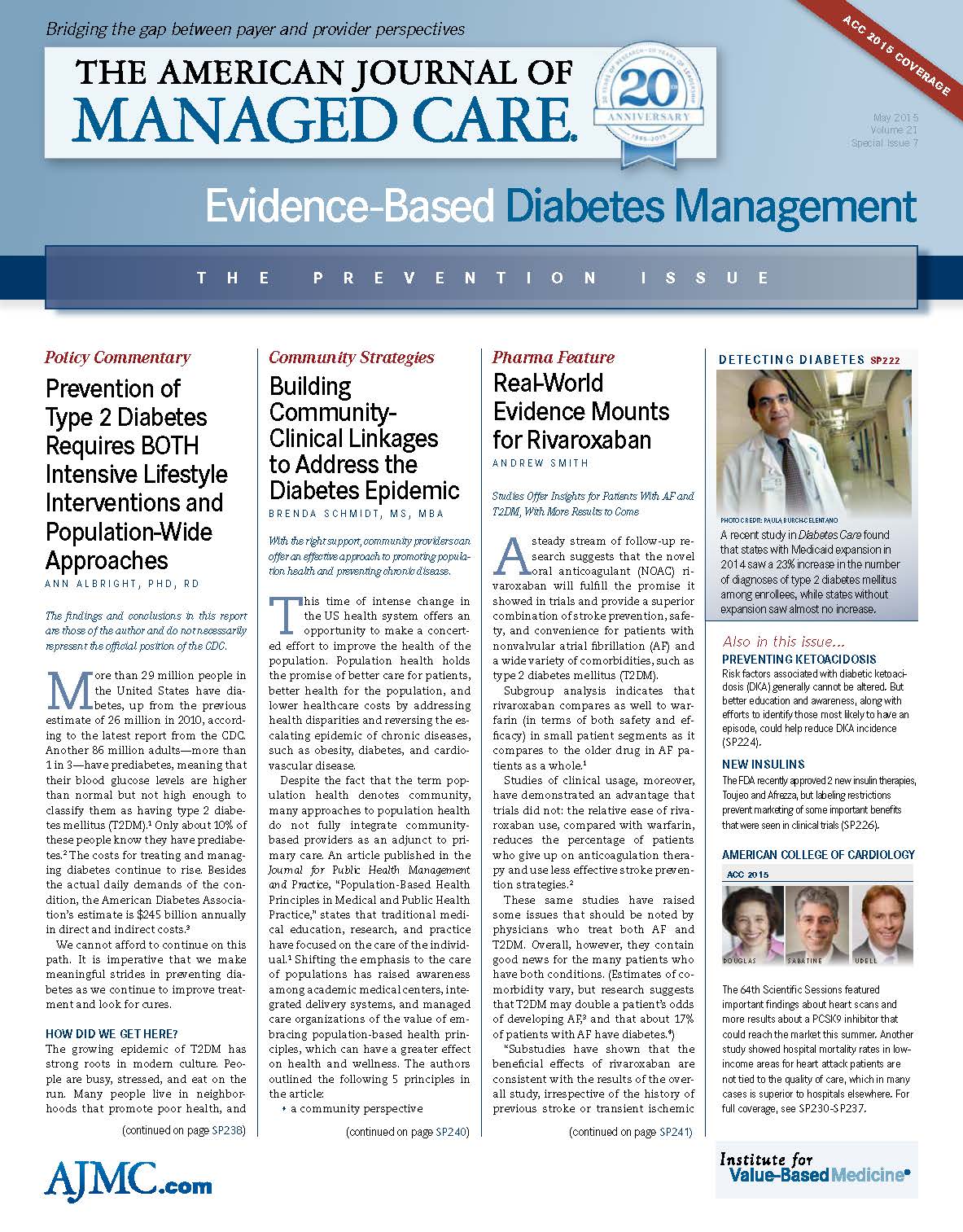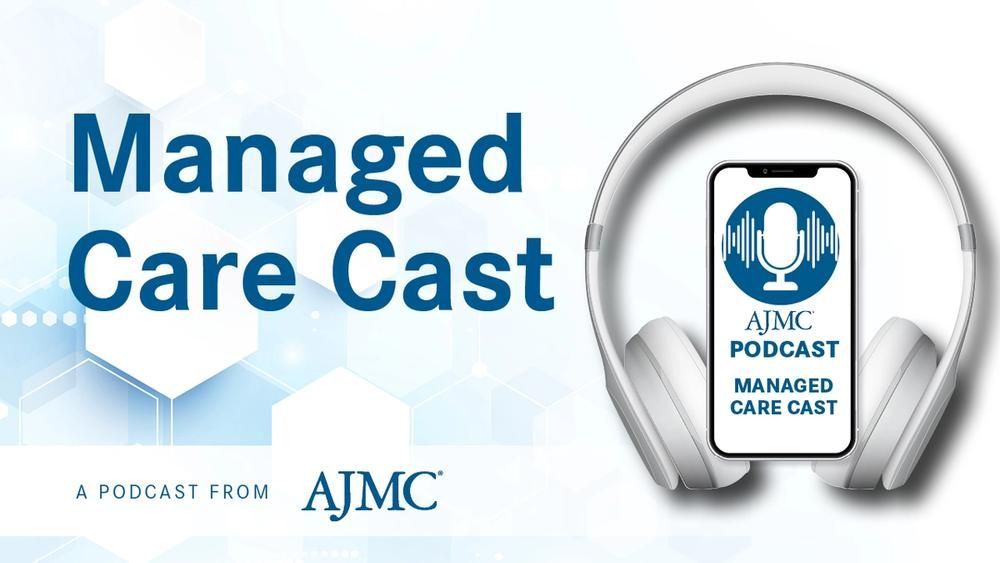Publication
Article
Evidence-Based Diabetes Management
Building Community-Clinical Linkages to Address the Diabetes Epidemic
Author(s):
With the right support, community providers can offer an effective approach to promoting population health and preventing chronic disease.
This time of intense change in the US health system offers an opportunity to make a concerted effort to improve the health of the population. Population health holds the promise of better care for patients, better health for the population, and lower healthcare costs by addressing health disparities and reversing the escalating epidemic of chronic diseases, such as obesity, diabetes, and cardiovascular disease.
Despite the fact that the term population health denotes community, many approaches to population health do not fully integrate community-based providers as an adjunct to primary care. An article published in the Journal for Public Health Management and Practice, “Population-Based Health Principles in Medical and Public Health Practice,” states that traditional medical education, research, and practice have focused on the care of the individual.1 Shifting the emphasis to the care of populations has raised awareness among academic medical centers, integrated delivery systems, and managed care organizations of the value of embracing population-based health principles, which can have a greater effect on health and wellness. The authors outlined the following 5 principles in the article:
• a community perspective
• a clinical epidemiology perspective
• evidence-based practice
• focus on outcomes
• emphasis on prevention.1
They contend that widespread awareness and adoption of these principles will have a profound impact on medical and public health education, practice, and ultimately the public’s health.1
DIABETES INCIDENCE, IMPACT, AND OPPORTUNITY
The United States is facing a looming diabetes epidemic. Diabetes affects 29 million Americans nearly 10% of the population and another 86 million American adults are estimated to have prediabetes, a condition that puts them at high risk for developing type 2 diabetes mellitus (T2DM). Between 15% and 30% of individuals with prediabetes who are overweight will develop T2DM within 5 years. Without prevention, 1 out of every 5 American adults will develop T2DM by 2025, and 1 out of 3 by 2050.2 T2DM has a disparate impact on racial and ethnic minorities. The risk of developing T2DM is 77% higher among African Americans, 66% higher among Latinos, and 18% higher among Asian Americans compared with Whites. Na-tive Americans are even more dispa-rately affected by diabetes. Nationwide, 16% of Native American adults are diagnosed with the disease, with rates soaring as high as 33% for some Tribal communities in the Southwest.3
In addition to a significant human toll, the financial cost of diabetes is staggering. In 2012, the total estimated cost of diabetes in the United States was $245 billion. The growth in the prevalence of T2DM predicts that di-rect medical costs will soar in the next 2 decades.4
Fortunately, T2DM is largely preventable. One of the most important keys to reversing this epidemic is increased access to evidence-based diabetes preven-tion programs for populations at high risk for developing diabetes. The solution requires a collaborative effort by health-care, public health, employers, insurers, and community organizations. The National Diabetes Prevention Program (National DPP) is the “gold standard” for diabetes prevention, with proven outcomes in multiple randomized controlled trials. The National DPP is a year-long community-based program delivered in a group-based setting in the community or more recently, delivered virtually supported by a trained lifestyle coach. The program helps people modify their eat-ing and physical activity habits and learn how to sustain lifestyle changes over time with a modest 5% to 7% weight loss goal. The National DPP has been shown to reduce the risk of developing T2DM by 58% for adults age 25 years and older with prediabetes, and by 71% for adults older than 60 years 5,6
THE NEED FOR COMMUNITY-CLINICAL LINKAGES
Scaling the National DPP in communi-ties across the nation is a critical step in combating the diabetes epidemic. The National DPP does not need to be tethered to a primary care setting. Numerous studies have cited the efficacy of the program as delivered by trained lay health educators in a variety of com-munity locations.7
Effective promotion of population health, including the prevention and control of diabetes, can only happen through true community collaboration that includes public health, social services, environmental support, and in-tegrated community providers. Indeed, true improvements in population health require a broad-based approach that ad-dresses a full range of social determi-nants of health from nutrition to employment to housing. One of the values of community-based delivery is the op-portunity to refer participants to addi-tional programs and services. When coordinating care with communitybased providers of the National DPP, primary care providers are introduced to the social conditions and community experience of their patients, such as poor housing. Those insights often lead providers to a new awareness of the need to address social conditions in order to improve health. Over the long term, chang-ing expectations and new approaches to community based population health will foster strong partnerships with communitybased organizations in order to address the social, emotional, and behavioral determinants of health as an adjunct to primary care.
BARRIERS TO EFFECTIVE COMMUNITY-CLINICAL LINKAGES
Currently, 625 organizations have been granted pending or full recognition sta-tus as National DPP providers by the Centers for Disease Control and Prevention (CDC) (http://www.cdc.gov/diabe-tes/prevention/recognition).8 Considering the 86 million people at high risk for developing T2DM, the need for a scalable, integrated DPP network is clear. However, disparate community-based and virtual DPP providers are not supported through a coordinated approach to patient identification, referrals, program delivery, and payment.
Physicians and other healthcare providers are encouraged to screen and refer high-risk patients to National DPP providers in their communities, or more recently, to virtual diabetes prevention programs. One challenge they face is the lack of a centralized searchable database or services directory for easily referring and enrolling patients into a “best-fit” program based on language, location, convenient class day, and convenient time. At present, healthcare providers can supply their eligible patients with a list of organizations offering the National DPP, relying on the patient to follow up directly with a provider organization. Unfortunately, these lists quickly become outdated due to the welcome proliferation of organizations offering the National DPP, including virtual DPP programs. Viridian has found that this this type of “opt-in” approach tends to result in significantly lower enrollment and engagement.
Community-based organizations delivering the National DPP, including the Black Women’s Health Imperative, the American Association for Diabetes Educators (AADE), the YMCA of the USA, and many faith-based organizations, are well suited to meet the diverse cultural needs of their local community members at high risk of developing T2DM. These community-based organizations are typ-ically not established partners to healthcare providers and insurers. They usually lack the operational infrastructure and systems necessary to manage and store large sets of data, or meet privacy and security standards required by the Health Insurance Portability and Accountability Act and the Health Information Technology for Economic and Clinical Health Act. They may not be ready to comply with health plan delegate oversight requirements, manage physician referrals, and submit claims to be reimbursed for their services. These organizations often do not have the technology to securely manage data from a variety of data sources and referral channels to identify individuals with prediabetes and manage the robust reporting requirements for employers, physicians, and insurers.
Insurers are beginning to adopt the National DPP as a covered benefit for their members. While this is an encouraging development, systems must be in place to support the delivery of the National DPP across large populations. Most National DPP providers do not have the infrastructure in place to sub-mit medical claims for their services. To ensure regional, statewide, and/or national capacity to cover plan members, health plans would need to contract independently with each community-based or virtual National DPP provider. Because so many community-based organizations find it difficult to comply with health plan delegate oversight requirements, the network of National DPP providers serving health plans is small and composed mostly of health-system—based programs. In 2010, UnitedHealthcare established the Diabetes Prevention and Control Alliance to address these issues and establish a mechanism to facilitate community clinical linkages to replicate the Y-DPP program through a national network of YMCAs.9
VIRIDIAN HEALTH MANAGEMENT: CREATING COMMUNITY-CLINICAL LINKAGES
While physicians, insurers, employers, and community-based organizations there face many challenges to creating effective community clinical linkages, successful models of integration are emerging. In November 2013, Trust for America’s Health convened national experts and local innovators to define practical steps to build a system that improves population health and reduces health disparities. The result was a summary report titled “Twin Pillars of Transformation: Delivery System Rede-sign and Paying for Prevention” (Trust for America’s Health, 2013). The report summarized successful emerging best practices and specifically called out the need for an “integrator” that coordi-nated alignment across clinical systems and community prevention.10
Viridian Health Management is a national corporation devoted to improving population health. Due to Viridian’s historic focus on the integration of public health, employee wellness, and clinical care, Viridian recognized the need for an “integrator” role to support the unification and alignment across a va-riety of National DPP stakeholders to support program reimbursement, referrals, and program delivery. Information technology capacity is a core function of the integrator. Ideally, population health technology links clinical, community, and social systems to address the needs of patients and communities. Data sharing between sectors, however, can be complicated and difficult, in part due to safeguards to protect patient privacy. While privacy regulations can be a barrier, they are not an insurmountable challenge. To achieve this, Viridian developed a module of its Maestro population health management technology. Maestro specifically supports the National DPP and other evidence-based chronic disease prevention and control programs that are delivered by com-munity-based organizations and integrated across systems. Viridian provides the Maestro SaaS-based platform at no charge to Viridian’s national network of community-based organizations to facilitate National DPP class management, data collection, and reimbursement by payers.
Through direct contracting with health plans, Viridian serves as a managed services organization to provide the operational infrastructure and technology needed to broadly scale the National DPP, and assumes the respon-sibilities for patient qualification and enrollment, data privacy and security, reporting, delegate oversight, physician referrals, and compliance. Viridian forms partnerships with organizations recognized by the CDC as National DPP providers, and provides administrative support to identify eligible patients; reaches out to and engages participants; provides a centralized database of providers, classes, and virtual programs; and enrolls participants into a National DPP program that best meets their needs. Viridian’s network includes a wide vari-ety of organizations that deliver the National DPP and are paid by Viridian when they achieve program milestone goals, including attendance and weight loss. Program reimbursement provides a sus-tainable revenue model for community-based providers that frequently rely on grant funding to support the costs of de-livering the program.
Collaboration with community based organizations that have widespread reach and are highly trusted and known to members of a community are key to scaling the National DPP. No single or-ganization has the capacity to provide the National DPP with more than a small share of the 86 million individuals who would benefit from the pro-gram. Community clinical linkages as an extension of primary care provide a model to address population health and chronic disease prevention and control as a best-practice model for population health.
Author Information: Brenda Schmidt, MS, MBA, is president and CEO, Viridian Health Management.
1. Ibrahim MA, Savitz LA, Carey TS, Wagner EH. Population-based health principles and public health practice. J Public Health Manag Pract. 2001;7(3):75-81.
2. 2014 National Diabetes Statistics Report. National Center for Chronic Disease Prevention and Health Promotion. CDC website. http:// www.cdc.gov/diabetes/pubs/statsreport14/ diabetes-infographic.pdf. Updated October 24, 2014. Accessed March 29, 2015.
3. New York Academy of Sciences website. Type 2 disparities in ethnic minorities: origin, challen-ges, and solutions. http://www.nyas.org/pub-lications/ebriefings/Detail.aspx?cid=cb49f35f-b765-435f-a53ae05bde1bd705. Published and accessed August 2012.
4. American Diabetes Association. Economic costs of diabetes in the U.S. in 2012. Diabetes Care. 36(4):1033-1046, 2013.
5. Knowler WC, Barrett-Connor E, Fowler SE, et al. Reduction in the incidence of type 2 diabetes with lifestyle intervention or metformin. N Engl J Med. 346(6):393-403, 2002.
6. National Diabetes Education Program website. Diabetes Prevention Program fact sheet. http:// www.ndep.nih.gov/resources/resourcedetail .aspx?ResId=132&redirect=true. Published 2012. Accessed July 2012.
7. Ackerman RT, Finch EA, Brizendine E, Zhou H, Marrero DG. Translating the Diabetes Prevention Program into the community: the DEPLOY pilot study. Am J Preven Med. 2008;35(4):357-363. 8. CDC website. National Diabetes Prevention Program. http://www.cdc.gov/diabetes/preven-tion/recognition/. Updated January 28, 2015. Accessed May 5, 2015.
9. Diabetes Prevention and Control Alliance. UnitedHealthcare website. http://www.healthin-numbers.com/innovation/diabetes-prevention-and-control-alliance/overview.aspx. Accessed May 5, 2015.
10. Trust for America’s Health. Twin Pillars of Transformation: Delivery System Redesign and Paying for Prevention. Washington, DC: Trust for America’s Health; 2013.

Newsletter
Stay ahead of policy, cost, and value—subscribe to AJMC for expert insights at the intersection of clinical care and health economics.





